NVIDIA nForce 500: Biostar and MSI Aim for the Gold
by Gary Key on June 8, 2006 4:30 AM EST- Posted in
- Motherboards
Synthetic Graphics Performance
The 3DMark series of benchmarks developed and provided by Futuremark are among the most widely used tools for benchmark reporting and comparisons. Although the benchmarks are very useful for providing apple to apple comparisons across a broad array of GPU and CPU configurations they are not a substitute for actual application and gaming benchmarks. In this sense we consider the 3DMark benchmarks to be purely synthetic in nature but still valuable for providing consistent measurements of performance.
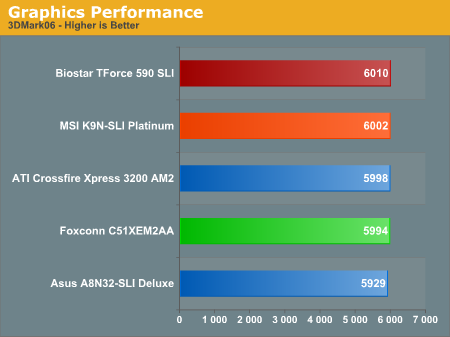
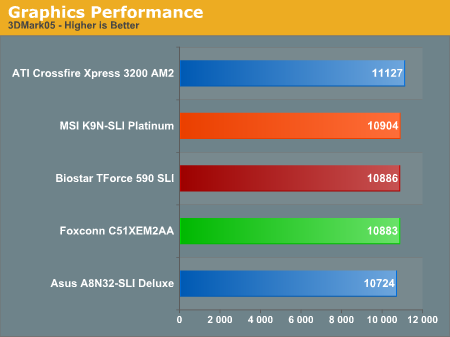
In our first tests, the Biostar and MSI boards lead the NVIDIA based systems by a small margin in each benchmark. However, the results are so close that it would be extremely difficult to determine a winner.
General System Performance
The PCMark05 benchmark developed and provided by Futuremark was designed for determining overall system performance for the typical home computing user. This tool provides both system and component level benchmarking results utilizing subsets of real world applications or programs. This benchmark is useful for providing comparative results across a broad array of Graphics subsystems, CPU, Hard Disk, and Memory configurations along with multithreading results. In this sense we consider the PCMark benchmark to be both synthetic and real world in nature while providing consistency in our benchmark results.
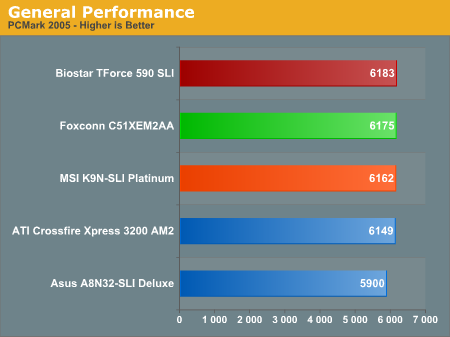
The margins are closer in the PCMark05 results but the Biostar board continues to show an advantage over the other NVIDIA based boards. Although these results are grouped tightly, this benchmark will show differences between platforms and provides an overview into how well each board will handle general office and video/audio applications along with simple multitasking of these program tests.
Rendering Performance
We have added the Cinebench 9.5 and POV-RAY 3.6 benchmarks as they heavily stress the CPU subsystem while performing graphics modeling and rendering. We utilize the standard benchmark demos in each program along with the default settings. Cinebench 9.5 features two different benchmarks with one test utilizing a single core and the second test showcasing the power of multiple cores in rendering the benchmark image.

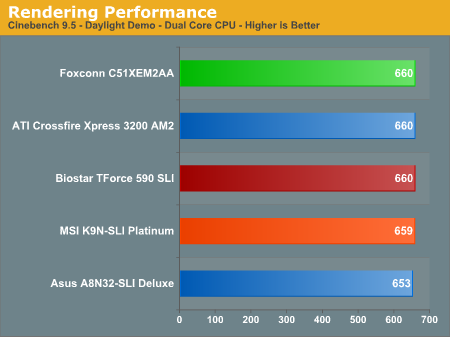
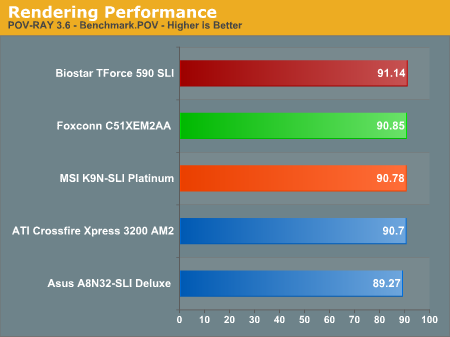
The Biostar board continues to make a strong showing in these benchmarks although all of the boards are tightly clustered in the scores. The Dual-Core Cinebench and POV-Ray results show the nForce 500 leading the nForce4 chipset by a measurable amount most likely due to the benefits of the increased DDR2 memory bandwidth.
The 3DMark series of benchmarks developed and provided by Futuremark are among the most widely used tools for benchmark reporting and comparisons. Although the benchmarks are very useful for providing apple to apple comparisons across a broad array of GPU and CPU configurations they are not a substitute for actual application and gaming benchmarks. In this sense we consider the 3DMark benchmarks to be purely synthetic in nature but still valuable for providing consistent measurements of performance.


In our first tests, the Biostar and MSI boards lead the NVIDIA based systems by a small margin in each benchmark. However, the results are so close that it would be extremely difficult to determine a winner.
General System Performance
The PCMark05 benchmark developed and provided by Futuremark was designed for determining overall system performance for the typical home computing user. This tool provides both system and component level benchmarking results utilizing subsets of real world applications or programs. This benchmark is useful for providing comparative results across a broad array of Graphics subsystems, CPU, Hard Disk, and Memory configurations along with multithreading results. In this sense we consider the PCMark benchmark to be both synthetic and real world in nature while providing consistency in our benchmark results.

The margins are closer in the PCMark05 results but the Biostar board continues to show an advantage over the other NVIDIA based boards. Although these results are grouped tightly, this benchmark will show differences between platforms and provides an overview into how well each board will handle general office and video/audio applications along with simple multitasking of these program tests.
Rendering Performance
We have added the Cinebench 9.5 and POV-RAY 3.6 benchmarks as they heavily stress the CPU subsystem while performing graphics modeling and rendering. We utilize the standard benchmark demos in each program along with the default settings. Cinebench 9.5 features two different benchmarks with one test utilizing a single core and the second test showcasing the power of multiple cores in rendering the benchmark image.



The Biostar board continues to make a strong showing in these benchmarks although all of the boards are tightly clustered in the scores. The Dual-Core Cinebench and POV-Ray results show the nForce 500 leading the nForce4 chipset by a measurable amount most likely due to the benefits of the increased DDR2 memory bandwidth.










17 Comments
View All Comments
Puddleglum - Thursday, June 8, 2006 - link
First comes AMD, then comes Intel. You must wait. Are you opposed to the 965/975x?Conroe comes out in about a month, so I'm sure you'll be seeing massive amounts of reviews in the coming weeks/days.
Myrandex - Thursday, June 8, 2006 - link
I don't know if it is just me, but it looks like in the graphical layout of the 570 that it says 16x connection to the first video card than an 8x connection to the second. I think it should have 16x / SLI (8x) or something on it.Jason
Myrandex - Thursday, June 8, 2006 - link
Also the following needs changed:The Realtek ALC-883 codec offers competitive CPU utilization rates when compared to the Realtek ALC-882 on the Asus board.
I think the Asus needs to be changed to Biostar.
JarredWalton - Thursday, June 8, 2006 - link
Asus changed to Biostar. As for the nF570 graphic, the X16 is because if you use a single GPU, you can get all 16 lanes, but if you use two GPUs, both will get 8 lanes. Yeah, it could be done better, but that image is direct from NVIDIA.Regards,
Jarred Walton
Editor
AnandTech.com
shortylickens - Thursday, June 8, 2006 - link
They jusy had to add two more digits, didnt they?Couldnt call it the Nforce 55, 57 and 59. Are they trying to compete on names again? Must need that extra digit I guess.
Before long we'll have Radeon XXXYYYZZZ9700 Thousand Million Pro Uber Leet Haxor and then we'll see GeForce 999 FXZ 88000 Ultra Grand Prix GT XML.
Then someone will get the idea to simplify the naming system and the whole mess starts over.
Visual - Friday, June 9, 2006 - link
Does the XML model also offer XSLT hardware acceleration? That'd rock, explorer is so slow on it...But I think I'll hold up for now till I can get the Turbo-Diesel Injection models.
Schizzlefuzz - Thursday, June 8, 2006 - link
I've only used Biostar for budget builds before, using DFI and Asus for performance builds, but the TForce 590 SLI Deluxe might be added when I start building AM2 systems for customers.